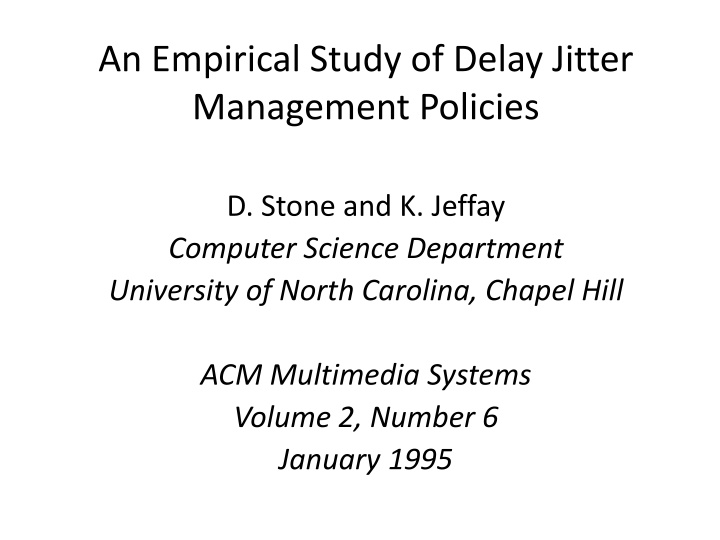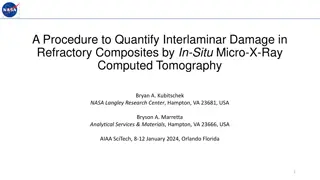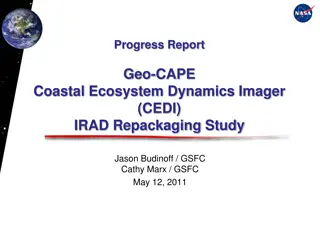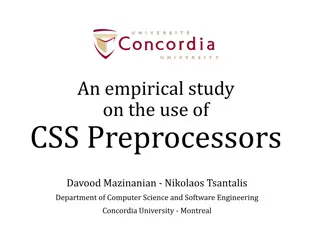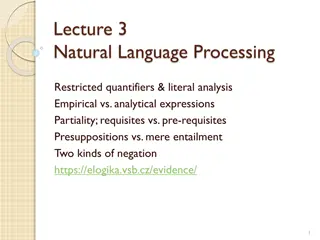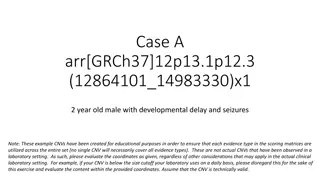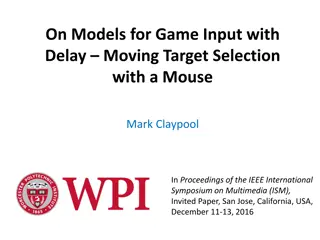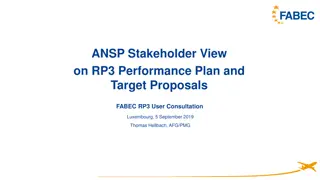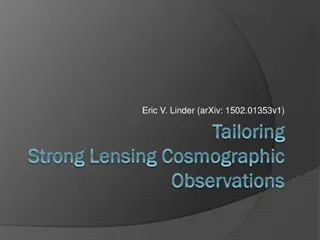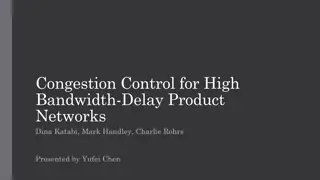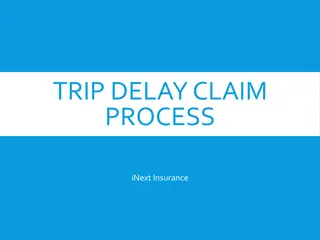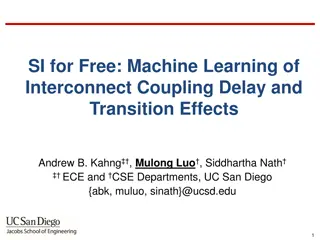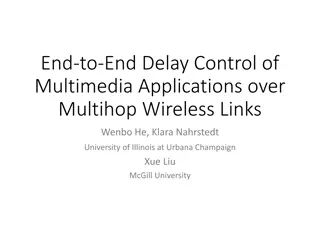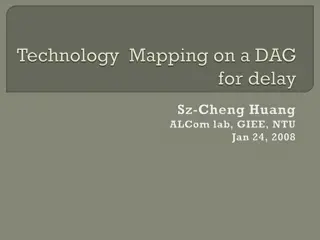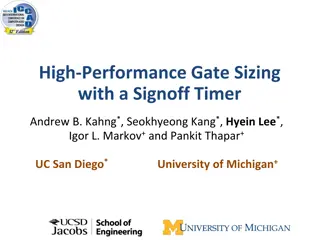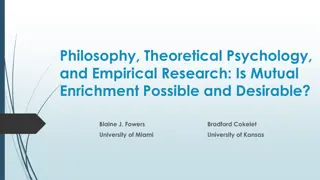An Empirical Study of Delay Jitter Management Policies
This study explores delay jitter management policies to support interactive audio over LANs, focusing on display queue management to minimize gaps in playout. The paper evaluates different queue management policies, including I-policy and E-policy, along with queue monitoring in the context of an empirical study on audio conferences. The effects of delay jitter on display latency and end-to-end delays are examined, highlighting the trade-offs between delay and gaps in real-time communication systems.
Download Presentation

Please find below an Image/Link to download the presentation.
The content on the website is provided AS IS for your information and personal use only. It may not be sold, licensed, or shared on other websites without obtaining consent from the author.If you encounter any issues during the download, it is possible that the publisher has removed the file from their server.
You are allowed to download the files provided on this website for personal or commercial use, subject to the condition that they are used lawfully. All files are the property of their respective owners.
The content on the website is provided AS IS for your information and personal use only. It may not be sold, licensed, or shared on other websites without obtaining consent from the author.
E N D
Presentation Transcript
An Empirical Study of Delay Jitter Management Policies D. Stone and K. Jeffay Computer Science Department University of North Carolina, Chapel Hill ACM Multimedia Systems Volume 2, Number 6 January 1995
Introduction Want to support interactive audio Last mile is LAN (including bridges, hubs) to desktop Study that (MLC: 1995 LANs looked a lot like today s WANs) Transition times vary, causing gaps in playout Can ameliorate with display queue (buffer)
Introduction (Frames) Display latency time from acquisition at sender to display at receiver (gap occurs if > previous frame) End-to-end delay time from acquisition to decompression Varies in time (transmit + (de)compress), delay jitter Queuing delay time from buffer to display (change size)
Gaps versus Delay Can prevent gaps by having constant delay Network reserves buffers Ala telephone networks But nottoday s Internet Plus will still have (unreserved) LAN as last mile OS and (de)compression can still cause jitter Thus, tradeoff between gaps and delay must be explicitly managed by conferencing system Change size of display queue The larger the queue, the larger the delay and the fewer the gaps and vice versa
This Paper Evaluates 3 policies for managing display queue I-policy and E-policy from [NK92] (I is for late data ignored, E is for late data expand time) Queue Monitoring from this paper Empirical study Audioconference (VoIP) on a LAN Capture traces Simulator to compute delay and gaps
Outline Introduction The I- and E-policies The Queue Monitoring policy Evaluation The Study Summary (done) (next)
The Effect of Delay Jitter If display latency worse than largest end-to-end latency, then no gaps (When is this not what we want?) Playout with low latency and some gaps preferable to high-latency and no gaps What if a frame arrives after its playout time? Two choices: I-policy single fixed latency (the queue parameter), so discard E-policy late frames always displayed, so expand playout time
I-Policy (3 gaps) (set display latency to 2)
E-Policy (1 gap, resulting display latency of 3 at end)
I-Policy (2) One event, but latency still low (set display latency To 1) (e, f, g, )
E-Policy (2) One event, latency higher
Policy Summary Display latency chosen implicitly with E-policy Choose it explicitly with I-policy What is the right display latency amount? Depends on application Example: surgeon interacting during operation vs. viewing televised lecture Depends on network and machines Can vary across a long run So, need a policy that allows display latency to be chosen dynamically
Outline Introduction The I- and E-policies The Queue Monitoring policy (next) Evaluation The Study Summary (done) (done)
Adjusting Display Latency VoIP with silence detection can be modeled as series of talkspurts Sound and then silence Adjust display latency between talkspurts [NK92] said observe last m fragments, discard k largest delays and choose display latency as greatest delay Recommend m > 40 and k = 0.07 x m (Other approaches proposed, since)
Monitor the Display Queue Measuring end-to-end latency is difficult because needs synchronized clocks Instead, observe length of display queue over time If end-to-end delay constant, queue size will remain the same If end-to-end delay increases, queue shrinks If end-to-end delay decreases, queue expands If queue length > 2 for some time, can reduce queue (hopefully) without causing a gap some time is parameter, n, in frame times Implement with counters for each of m frames in queue If any of the m times > n, discard frame and reset (However, keep queue at least 2) Use QM-120 as default Adjust every 120 frames (about 2 seconds)
Outline Introduction The I- and E-policies The Queue Monitoring policy (done) Evaluation The Study Summary (done) (done) (next)
Comparing Policies If A has lower latency and gaps than B, then A is better If A lower latency, but also A more gaps then which is better? Depends upon relative amounts resolution application requirements Few standards
Comparing Policies Assume: Differences in latency of 15 ms or more significant Difference in gap rate of 1 per minute significant A is better than B if either gap or latency better and other is same or better Equal if same in both dimensions Incomparable if each is better in one dimension Note, for I-policy, synchronized clocks difficult Instead, delay first packet for amount of time (try 2 and 3 frames in this paper)
Outline Introduction The I- and E-policies The Queue Monitoring policy (done) Evaluation The Study Summary (done) (done) (done) (next)
The Study Run videoconference Use audio only Record end-to-end delay Input into simulator to evaluate different policies Effectively, a trace-driven simulation Ensures network conditions the same when comparing policies
Videoconference Built at UNC Runs on IBM PS/2 Uses UDP IBM-Intel ActionMedia 750 30 fps, 256x240, 8-bit color (6-8 k frames) But video is disabled Audio 60 fps, 128 kb/second into 16.5ms frames (266 byte packets)
Network 10 Mb Ethernets and 16 Mb token rings 400 Unix workstations and Macs NFS and AFS (file systems) Send machine token-ring gateway department Ethernet bridge department Ethernet gateway token- ring Display machine
Data Gather data for 10 minute interval 28 Runs total 24 runs between 6am and 5pm 4 runs between midnight and 1am Record: Acquisition times Display times Adjust times for clock difference and drift Input traces into simulator Outputs average display latency Outputs average gap rate
Basic Data (Comments?)
Two Example Runs Low jitter High jitter
Results QM-120 better than I-2 for all but 11 (I-2 has gap per 2 seconds vs per 11 seconds)
Results QM-120 better than I-3 for all but 15 Latency of QM-120 better than that of I-3 Better than E for low jitter runs
Summary Results If want low latency, not large gap rate QM out performs all I-policies, E-policies
Threshold as a Parameter Vary thresholds for adjusting queue latency 30 frame times (.5s) 60 frame times (1s) 120 frame times (2s) 600 frame times (10s) 3600 frame times (1 min)
Results Comments?
Summary QM-600 is best relative to QM-120 QM-120 better than all others (MLC: what about in between? Should be optimal for each setting) Also: QM-3600 similar to E-policy QM-30 and QM-60 similar to I-2
Decay Thresholds Want to converge slowly to lowest latency Define base threshold for queue length of 3 Define decay factor for other queue lengths Base of 3600, decay of 2 would have: Wait 3600 frame times when queue is 3 1800 for 4 900 for 5
Summary Results QM-(120,2) didn t help QM-(600,2) better than QM-120 Also better than QM-600 by decreasing latency and gap rate almost the same QM-(3600,2) better than QM-120 Also better than QM-3600 So, decay is useful for large base thresholds, but may hurt for small base thresholds
Summary Will always be delay From network or OS or Need to adjust queue latency QM-(600,2) is the best, QM-120 almost as good Queue monitoring can be effective 35-40 ms delay, variation up to 200ms, even 80 ms when quiet Run 3 Best vs. E-policy E: 140ms, .9 gaps/min QM-(600,2): 68ms, 1.4 gaps/min Run 24 Best vs. I-policy I: 93 ms, 15 gaps/min QM-(600,2): 90 ms, 4 gaps/min QM is flexible, can be tuned to app or user
Future Work Compare against I-policy where threshold changes each talkspurt Compare using different metrics, say that combine latency and gaps or looks at distribution PQ studies to measure tradeoffs Larger networks Combine with repair Other decay strategies for QM
